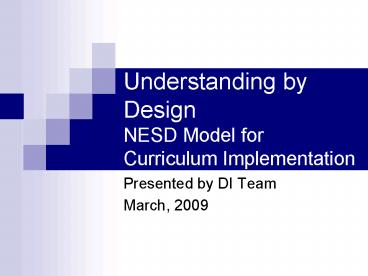Understanding by Design NESD Model for Curriculum Implementation - PowerPoint PPT Presentation
1 / 11
Title:
Understanding by Design NESD Model for Curriculum Implementation
Description:
Meeting the Learner Needs. Invites us to attend to the ... Links to curriculum. They require new thought rather than the mere collection of facts, second-hand ... – PowerPoint PPT presentation
Number of Views:277
Avg rating:3.0/5.0
Title: Understanding by Design NESD Model for Curriculum Implementation
1
Understanding by DesignNESD Model for Curriculum
Implementation
- Presented by DI Team
- March, 2009
2
What is Understanding by Design (UbD)?
- Unit-planning process
- Created by Grant Wiggins and Jay McTighe
- Known as backwards design
- Begins with the end in mind
- Beginning stages of UbD
3
Basic Stages of UbD
- Stage 1Identify desired results
- Curriculum Goals and Learner Outcomes
- Big Ideas
- Essential Questions/ Enduring Understandings
- Know/ Understand/ Do
- Stage 2 Determine acceptable evidence
- Formative/Summative Assessments
- Stage 3 Plan learning experiences and
instruction - Developing the Learning Plan
- Consider how to differentiate
4
- Stages of Backward Design
5
Curriculum Actualization
- UbD requires teachers to examine curriculum to
align the learning plan/assessment with
provincial expectations - UbD leads students and teachers to higher level
of thinking and inquiry - Links assessment directly to learning outcomes
6
- Establishing Curricular Priorities
7
Meeting the Learner Needs
- Invites us to attend to the child
- Allows for scaffolding for students
- Clarifies outcomes that all children are expected
to learn - Clarifies what students need to understand, know,
do
8
The How-tos of UbD
- Categories within the process are most important
- Many entry points
- UbD takes time to do well
- Units are often revised as teachers reflect on
effectiveness - Process may guided by organizer use
9
Big Ideas
- Invite higher levels of thinking
- Requires uncovering throughout the unit
- Transfers across grades or subject areas
- A big idea is a way of usefully seeing
connections, not just another piece of
knowledge..it is more like a theme than the
facts of a story. (Grant Wiggins, 2007)
10
Essential Questions/Enduring Understandings
- Stimulates thought, provokes inquiry, and
generates questions - Interdisciplinary invites you to transfer and
apply learning - Links to curriculum
11
- They require new thought rather than the mere
collection of facts, second-hand opinions, or
cut-and-paste thinkingmany of us believe that
schools should devote more time to essential
questions and less time to Trivial Pursuit.
(Jamie McKenzie, 2008)































